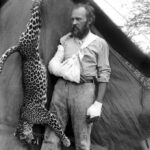
This incredible feat, which demonstrated both his bravery and his deep connection to nature, solidified Akeley’s reputation as a pioneering figure in the field of natural history. Known for revolutionizing taxidermy with innovative techniques, he forever changed how animals were preserved for museum exhibits, setting the standard for modern practices that are still in use today.
Akeley was not just a taxidermist; he was a gifted sculptor, biologist, and conservationist. His expeditions to Africa, where he studied wildlife and captured specimens for his work, played a pivotal role in his career. Akeley’s most famous achievement was his work on the dioramas at the American Museum of Natural History in New York, where he created lifelike exhibits that brought the animal kingdom to life for visitors, blending art and science in groundbreaking ways.
The leopard attack during one of his African expeditions highlighted Akeley’s resourcefulness and understanding of animal behavior. Despite the danger, he successfully subdued the animal in a life-threatening struggle, earning admiration from the scientific community and further cementing his legacy. Beyond his taxidermy work, Akeley was also an advocate for conservation, helping establish Africa’s first wildlife preserves and making lasting contributions to the protection of endangered species. His legacy endures through his scientific work, his impact on museum exhibits, and his dedication to preserving the natural world










Leave a Reply